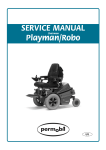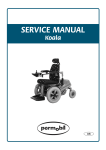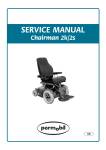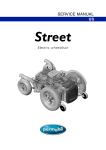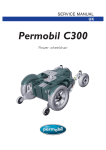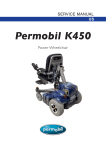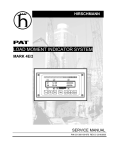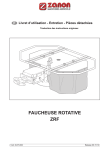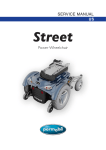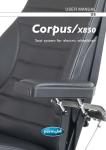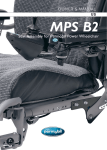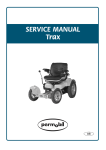Download SERVICE MANUAL Entra
Transcript
SERVICE MANUAL Entra Chairman US How to contact Permobil Permobil Inc. USA 6961 Eastgate Blvd. Lebanon, TN 37090 USA Phone: 800-736-0925 Fax: 800-231-3256 Email: [email protected] Head Office of the Permobil group Permobil AB Box 120, 861 23 Timrå, Sweden Tel: +46 60 59 59 00. Fax: +46 60 57 52 50 E-mail: [email protected] Produced and published by Permobil AB, Sweden Edition no.2, 2006-01 Article no.: 201165-US-0 Contents Contents Introduction ..................................................................................................... Technical support......................................................................................... Spare parts .................................................................................................. Warranties.................................................................................................... Maintenance ................................................................................................ 5 5 5 5 5 Identification plates ........................................................................................ Chassis ........................................................................................................ Pilot+ output stage....................................................................................... Control panel ............................................................................................... 6 6 6 6 Operating the seat lift manually .................................................................... 7 Cover................................................................................................................ 7 Batteries........................................................................................................... 8 Drive wheels.................................................................................................... 9 Support wheels ............................................................................................... 10 Brake release .................................................................................................. 11 Magnetic brakes.............................................................................................. 12 Drive motors.................................................................................................... 15 Seat lift............................................................................................................. 17 Seat lift cable ............................................................................................... 18 Seat lift motor .............................................................................................. 19 Seat lift drive belt............................................................................................ 20 Changing the seat lift drive belt ................................................................... 20 Adjusting the belt tension ............................................................................ 20 Pilot+ output stage ......................................................................................... 21 SLS drive stage............................................................................................... 21 Control panel................................................................................................... 22 Seat Control Panel.......................................................................................... 22 Circuit breaker and fuses .............................................................................. Circuit breaker ............................................................................................. Charge fuse ................................................................................................. Fuse for seat/lights ...................................................................................... 23 23 24 24 Trouble Shooting ............................................................................................ 25 Distribution chart............................................................................................ 26 4 Introduction Introduction The Service Manual is intended for technical personnel who maintain and repair electric wheelchairs. It is important that anyone who performs maintenance and repairs described in this manual reads and understands the content of this manual so that the work is performed professionally. Always state the chassis number when contacting Permobil to ensure that the correct information is provided. Technical Support In the event of technical problems, you should contact your dealer, or Permobil Inc. USA at 800-736-0925. Spare parts Spare parts must be ordered through your dealer. Warranties Contact your dealer or Permobil Inc. USA for information about the warranties for this chair. Maintenance See the information in the Owner’s Manual. 5 Identification plates Identification plates Chassis Fig.1. Chassis identification number. Pilot+ output stage Fig. 2. Pilot+ output stage identification number. Control panel Fig. 3. Control panel identification number. 6 Operating the seat lift manually/Cover Operating the seat lift manually Warning! Using a drilling machine during the manual operation of the seat lift is not allowed. There is a risk of material damage. Electric seat lift If the seat lift will not move up normally, because the battery is flat or the adjusting mechanism is broken, you can raise the seat manually. 1. 2. Remove the cushion from the seat. Raise the seat using the seat lift crank supplied (part number 303668-99-0). Fig. 4. Using the seat crank to raise the seat. Manual seat lift 1. 2. Remove the cover and plastic plug from the seat. Loosen the seat tube clamp screw. 3. Crank up the seat using the seat lift crank supplied, see figure 4. 4. Tighten the seat tube clamp screw. Torque: 11 ft.Ib Fig. 5. The seat tube clamp screw. Cover Removing 1. 2. 3. Raise the seat to its highest position. Unscrew the three plastic knobs that hold the cover. Remove the cover. Fitting 1. 2. Position the cover on the chassis. Screw in the three plastic knobs that hold the cover. Fig. 6. The cover is held on by three plastic knobs. 7 Batteries Batteries O n NB! Use protective goggles when working on batteries. O ff Removing 1. Put the wheelchair on a level surface. 2. Raise the seat. To raise the seat manually, see page 7. 3. Switch off the power using the control panel. 4. Put the circuit breaker to the “OFF” position, see fig. 7. 5. Remove the cover, see page 7. 6. Disconnect the battery leads, positive terminals first. Fig.7. Circuit breaker/Battery isolator. 7. Lift out the batteries. Fitting 1. Lift the batteries into position, with the terminals at the front, see fig. 8. 2. Reconnect the battery leads, negative first. 3. Refit the cover. 4. Put the circuit breaker to the “ON” position, see fig. 7. 5. Lower the seat. For manual lowering, see page 7. Fig.8. Battery connections. 8 Drive wheels Drive wheels Removal 1. Switch off the main switch. 2. Lift up the chair and support it on blocks, so that the wheels are off the ground. 3. Undo and remove the hubcap (5), bolt (4) and washers (2 and 3), see fig. 10. 4. Pull the wheel off the shaft. Use puller 304103-99-0 if the wheel is tight, see fig. 9. Fitting Fig. 9 Puller 304103-99-0. 1. Check the axle and rim for any damage. If necessary, you should clean these parts of dirt and rust. If any parts are damaged, they should be replaced. 2. Check that the key fits solidly in the keyway of the axle. If necessary, install the new key and check for fit. 3. Lubricate the shaft with a thin layer of copper paste (Würth 0893800x, Art. no.: 1820540). 1 Warning! Do not use any type of lubrication in the threaded hole in the axle or on the bolt. If necessary, you should clean these parts. 5 2 4 3 4. Fit the wheel onto the axle. The use of hand force only is preferred, but, if need be, carefully use a rubber mallet, whose head diameter is no less than 1.5 inches (38 mm), to ensure that the rim is fully seated upon the motor. NB! Hitting too hard with a rubber mallet could cause damage to the gear. 5. Put the washers (2 and 3) onto the bolt (4) and tighten the wheel, see fig. 10. Use a torque wrench to tighten the bolt to 18 ft-Ibs. Install the hub cap (6), see Fig. 10. 1. Front wheel 2. Washer, TBRSB 8.4x26x5 NB! The bolt must be used once only. Removed bolt is not allowed to be refitted. 3. Washer, Nordlock M8x16.6, glued. 4. Bolt, Eslock MC6S M8x35 5. Hubcap Fig. 10. Wheel attachment. Warning! Other types of bolts or washers are not to be used.. Warning! Do not use any other type of thread lock. 9 Support wheels Support wheels Support wheels are fitted as standard to seats supplied with the Corpus II seat. Removing 1. Switch off the power using the control panel. 2. Remove the drive wheel on the relevant side, see page 9. 3. Remove the two screws, see fig. 11. Fitting Fitting is the reverse procedure. Fig.11. Removing a support wheel. Adjusting The degree of flex of the support wheels can be adjusted using the adjusting screw on front of the bracket. NB! For the Entra, the support wheel should always flex as little as possible, i.e. the adjusting screw should be tightened right down. Screw the adjusting screw fully down, then lock it with the locknut fitted to it, see fig. 12. Fig.12. Adjusting a support wheel. 10 Brake release 1 2 Fig.13. Brake release mechanism. Brake release cables The upper cable controls the left brake unit and the lower cable controls the right brake unit. Removing Fitting 1. Raise the seat lift to its highest position (for chairs without a seat lift, use the crank supplied) see page 7. Remove the cover, see page 7. Move the brake release lever fully forwards to facilitate removal. 1. Attach the cable to the magnetic brake, then to the release lever. 2. Adjust the length of the cable sleeve using the adjusting screw (13:2), so that the cable is tensioned but does not pull the release link. 3. Slacken the locknut (13:1). 3. 4. Screw the adjusting screw (13:2) fully in. Check the operation. Operate the release lever to release the brake and check that the wheel can turn. 5. Detach the cable at the magnetic brake and brake release mechanism. 4. Refit the cover, see page 7. 2. Brake release sensor Removing 1. 2. Raise the seat lift to its highest position (for chairs without a seat lift, use the crank supplied). Remove the cover, see page 7. Switch off the power using the control panel. 3. Put the circuit breaker to the “OFF” position, see page 8. 4. Remove the two screws holding the sensor, see fig.14:1. 5. Cut off the two ties and disconnect the cable connector, see fig. 14. 1 Fig.14. Brake release sensor. Fitting Fitting is the reverse procedure. 11 Magnetic brakes Magnetic brakes Removing 1. Raise the seat lift to its highest position (for chairs without a seat lift, use the crank supplied) see page 7. 2. Remove the cover, see page 7. Move the brake release lever fully forwards to facilitate removal. 3. Switch off the power using the control panel. 4. Put the circuit breaker to the “OFF” position, see page 7, and remove the batteries, see page 8. 5. Disconnect the magnetic connector, see fig. 15. brake Fig.15. Magnetic brake electrical connector. electrical 6. Pull the cable sleeve forwards and take the cable out through the slot in the cable mounting. Unhook the brake release cable from the magnetic brake, see fig. 16. Fig.16. Brake release cable. 7. Unscrew the three bolts that hold the brake. Remove the brake, complete with the disc and cover. 8. Note the position of the brake release arm, see fig. 17. Fig.17. Magnetic brake fixing bolts. 12 Magnetic brakes Fitting 1. Use the adjusting screws to adjust the magnetic brake. Set both screws flush with back surface of the brake, then turn the screws downwards 3/4 turn, see fig. 18. Fig.18. Adjusting the magnetic brake using the two adjusting screws. 2. Fit the brake disc into the magnetic brake, see fig. 19. Fig.19. Magnetic brake, brake disc and cover removed. 3. Fit the cover, see fig. 20. Fig.20. Magnetic brake, brake disc and cover fitted. 13 Magnetic brakes 4. Insert a bolt to align the parts then secure the magnetic brake using the three bolts, see fig. 21. Fig.21. Use one of the fixing bolts to align the parts with one another. 5. Connect the magnetic connector, see fig. 22. brake electrical Fig.22. Magnetic brake electrical connector. 6. Fit the brake release cable, see fig. 23. 7. Fit the batteries, see page 8. 8. Put the circuit breaker to the “ON” position, see page 8. 9. Fit the cover, see page 7. Fig.23. Magnetic brake release cable. 14 Drive motors Drive motors Removing O ff O n 1. Raise the seat lift to its highest position (for chairs without a seat lift, use the crank supplied) see page 7. 2. Switch off the power using the control panel. 3. Remove the cover, see page 7. Move the brake release lever fully forwards to facilitate removal. 4. Put the circuit breaker to the “OFF” position, see fig. 24. 5. Raise the relevant side of the chair using the Permojack or raise the chair on blocks. Fig.24. Circuit breaker/Battery isolator. 6. Remove the wheel, see Changing drive wheels, page 9. 7. Disconnect the electrical connectors for the motor and magnetic brake, see fig. 25. Fig.25. Magnetic brake and drive motor electrical connectors. 8. Pull the cable sleeve forwards and take the cable out through the slot in the cable mounting. Unhook the brake release cable from the magnetic brake, see fig. 26. Fig.26. Brake release cable. 15 Drive motors 9. Remove the three bolts holding the cover plate, and remove the cover plate. Remove the three bolts holding the motor, see fig 27. Fig.27. Drive motor and cover plate fixings. 10. Turn the motor sideways to free the wheel shaft. Pull the motor straight forwards. Fitting Fitting is the reverse procedure. Fig.28. Removing a drive motor. 16 Seat lift Seat lift Removing 1. Raise the seat lift to its highest position (for chairs without a seat lift, use the crank supplied), see page 7. 2. Switch off the power using the control panel. 3. Put the circuit breaker to the “OFF” position, see page 8. 4. Remove the cover. 5. Disconnect the seat lift cable, see fig. 29. Fig.29. Seat lift cable. 6. Lift off the seat and lay it at the side, next to the chassis, see fig. 30. NB! The seat is heavy, so two people should lift it. Fig.30. Lift off the seat. 7. Remove the two bolts from the upper mounting, see fig. 31:1. 8. Remove the two bolts in the lower mounting, see fig. 31:2. 9. Lift off the seat lift. 1 2 Fig.31. Removing the drive motor. 17 Seat lift The upper part of the seat lift is mounted on the seat and can be detached as described in the following. 10. Unscrew and remove the two screws holding the seat plate, see fig. 32. Fig. 32. The seat plate is mounted with two screws. 11. If the seat is equipped with seat tilt, unfasten the actuator’s front bracket, see fig. 33. Draw the seat tilt mechanism apart, see fig. 34. 12. Unscrew and remove the four screws holding the seat lift, see fig. 34 and 35. Fitting Fitting is performed in reverse order. Fig. 33. Unfasten the front bracket on the seat tilt actuator. Fig. 35. Seat without seat tilt, the upper part of the seat lift is mounted with four screws. Fig. 34. Seat with seat tilt, the upper part of the seat lift is mounted with four screws. 18 Seat lift cable Seat lift cable Removing 1. Remove the seat lift; follow the instructions on page 17. 2. Remove the seat lift sensors. Note the position of the sensors for refitting, see fig. 36. Fitting Fitting is the reverse procedure. NB! After fitting, check that the arm of the rollerswitch can move freely. Fig.36. Attachment of the sensors to the seat lift. 1. 2. 3. 4. 5. 6. 7. Screw Rollerswitch plate Rollerswitch Insulating plate Seat lift Plate Nut 1 2 3 2 4 5 6 7 Fig.37. Attachment of the sensors to the seat lift. 19 Seat lift motor Seat lift motor Red (Green)* Removing 1. Remove the seat lift, see page 17. 2. Disconnect the seat lift cable at the motor; note the position of the connectors, see fig. 38. 3. Green Remove the seat lift motor by taking out the three bolts that hold it, see fig. 39. Blue Blue (Red)* Fig.38. Note the connector colors. * Certain early models might have these cable colors. Fitting 1. Put in the new motor and tighten the three bolts. 2. Replace the seat lift motor cable. Pay attention to the position of the connectors. Fig.39. The motor is attached by three bolts. 20 Seat lift drive belt Seat lift drive belt Removing 1. Remove the seat lift, see page 17. 2. Loosen the two bolts holding the shaft to the seat lift motor. Push the shaft sideways to slacken the drive belt. 3. Remove the belt from the motor shaft, then from the toothed wheel on the seat lift screw. 4. Fit the new belt using the reverse procedure. 5. Adjust the belt tension as described below. 6. Fit the seat lift, see page 17. Fig.40. The seat lift shaft is attached by two bolts. Adjusting the belt tension 1. Loosen the two bolts near the belt, see fig. 40. 2. Adjust the belt tension by moving the motor shaft sideways. 3. Tighten the two screws. 4. Check the belt tension. The belt is correctly tensioned when it can be pressed in 0.15”-0.20”, see fig. 41. 0.15”-0.20” (4-5 mm) Fig.41. The drive belt tension can be adjusted after the two bolts have been loosened. 21 Pilot+ output stage & SLS drive stage Pilot+ output stage Removing 1. Raise the seat lift to its highest position (for chairs without a seat lift, use the crank supplied) see page 7. 2. Switch off the power using the control panel. 3. Put the circuit breaker to the “OFF” position, see page 8. 4. Remove the cover, see page 7. Move the brake release lever fully forwards to facilitate removal. 5. Lift up the output stage. Fig.42. The SLS drive stage and Pilot+ output stage. 6. Disconnect the electrical connectors from the output stage, note their locations, see fig. 43. Fitting Fitting is the reverse procedure. SLS drive stage Removing 1. Raise the seat lift to its highest position (for chairs without a seat lift, use the crank supplied) see page 7. 2. Switch off the power using the control panel. 3. Put the circuit breaker to the “OFF” position, see page 8. 4. Remove the cover, see page 7. Move the brake release lever fully forwards to facilitate removal. 5. Lift up the drive stage. Fig.43. Electrical connectors for the Pilot+ output stage. 6. Pull the cover off the drive stage. 7. Cut off the ties holding the cables, and disconnect the electrical connectors, note their locations. Fitting Fitting is the reverse procedure. See the cover of the SLS box for reference. Fig.44. Electrical connectors for the SLS drive stage. 22 Control panel Control panel Removal 1. 2. Switch off the main power switch on the control panel. Put the circuit breaker in the “OFF” position, see page 24. 3. Disconnect the control panel cable by pulling the connector at the rear of the control panel straight backwards. 4. To remove the control panel, remove the screws holding the common bracket for the control panel and Seat control panel, see fig. 45. Remove the control panel bracket by removing the two screws on the rear of the control panel, see fig. 46. Fig. 45. The Control panel and Seat control panel bracket. Fitting Fitting is the reverse procedure. Seat control panel Removal 1. 2. Switch off the main power switch on the control panel. Put the circuit breaker in the “OFF” position, see page 24. 3. Remove the cover of the Seat control panel by pulling it straight upwards. If the lid is stuck, you can carefully use a screwdriver to pry between the lid and the lower part of the end of the box, see fig. 47. 4. You can now lift the circuit board and cable out of the box. 5. Disconnect the cable from the circuit board by pulling the connector straight upwards, see fig. 48. 6. To remove the control panel, remove the screws holding the common bracket for the control panel and Seat control panel, see fig. 45. Remove the Seat control panel bracket by removing the two screws on the underside of the box, see fig. 46. Note the position of the bracket for refitting. Fig. 46 The Control panel and Seat control panel fixings. Fitting Fitting is the reverse procedure. Fig. 48. The Seat control panel electrical connector. Fig. 47. Removing the Seat control panel lid. 23 Circuit breaker and fuses Circuit breaker and fuses Resetting the circuit breaker O ff O n The circuit breaker also acts as a battery isolator, but is usually referred to as the circuit breaker. You will not normally need to change the circuit breaker, as you can reset it when it has tripped. It is located on the left side of the chassis, next to the seat tube, see fig. 49. NB! A tripped circuit breaker often means that there is a serious electrical fault. Check the cause thoroughly before you reset the circuit breaker. Fig.49. Circuit breaker/Battery isolator. Changing the circuit breaker 1. Remove the cover, see page 7. 2. Switch off the main power switch on the control panel. 3. Put the circuit breaker to the “OFF” position, see fig. 49. 4. Disconnect the battery positive lead, which is between the battery and the circuit breaker. 5. Remove the circuit breaker by removing the two screws, see fig. 50. NB! Note the orientation of the circuit breaker for refitting. The ON/OFF positions must agree with the label 6. Disconnect the cables from the circuit breaker by loosening the screws, see fig. 51. 7. Connect the cables to the new circuit breaker. Put the circuit breaker to the “OFF” position. Fig.50. Circuit breaker fixings. 8. Attach the new circuit breaker with the two screws, see fig. 50. NB! Check the orientation of the circuit breaker. The ON/OFF positions must agree with the label. 9. Reconnect the battery positive lead. 10. Fit the cover, see page 7. 11. Put the circuit breaker to the “ON” position, see fig. 49. Fig.51. Circuit breaker electrical connections. 24 Circuit breaker and fuses Changing the charge fuse The charge fuse is at the front of the chassis, see fig. 52. Switch off the main supply and the charger, if in use, before you change the charge fuse. NB! The circuit breaker must be in the “ON” position during charging. Fig.52. Charge fuse. Changing the seat/lights fuse There are two fuses in the SLS drive stage, F1 (24V unswitched) and F2 (24V switched). These protect two outlets, located to the left of the SLS drive stage, next to the charge socket. One of the outlets (24V unswitched) supplies power irrespective of whether the chair is switched on or off. The other outlet (24V switched) supplies power only when the chair is switched on. The seat and lights are normally connected to this outlet. F1 F2 1. Remove the cover, see page 7. 2. Switch off the power using the control panel. 3. Put the circuit breaker to the “OFF” position, see page 8. 4. Lift up the SLS drive stage, see page 22. Fig.53. Fuses. 5. Pull the lid off the SLS drive stage. F1 = 24V unswitched, 15A. F2 = 24V switched, 15A, Seat/Lights. 6. Change the blown fuses. 7. Put the lid back on the box. 8. Put the SLS drive stage back in place in the chassis. 9. Put the circuit breaker to the “ON” position, see page 8. 10. Refit the cover, see page 7. 25 Troubleshooting Troubleshooting Battery voltage indicator The battery voltage indicator shows the status of the wheelchair. Steady Display Flashing slowly Flashing quickly - Everything is working correctly. - The batteries need to be charged. - Fault signal. A fault has occurred and the wheelchair can not be driven. Fault signals The number of flashing lights indicates the fault. – Note the number of flashing lights. – Switch off the chair. – Switch the chair back on. – If the fault is still there, count the number of flashing lights, then look up the possible cause and action in the table below. CAUSE High battery voltage LEDs 10 ACTION Check the battery and the connections between the battery and control unit. Break in the brake circuit 9 Check the connections to the magnetic brake. Fault in the electronics 8 Check the connections to the output stage. If the fault persists, change the output stage. Fault in the control panel 7 Make sure the joystick isn’t actuated at switchon, change the control panel. 6 Short circuit, right drive motor 5 Check the motor connections and cable. Open circuit, right drive motor 4 Check the connection to the right drive motor. Short circuit, left drive motor 3 Check the motor connections and cable. Open circuit, left drive motor 2 Check the connection to the left drive motor. Low battery voltage 1 Check the condition of the battery. Check the connection between the battery and the control unit. 26 Distribution Chart 1 2 3 A B C D E F 28 4 Distribution Chart 5 6 7 8 A B C D E F Distribution chart 29 Notes 30 Article no.: 201165-US-0
































